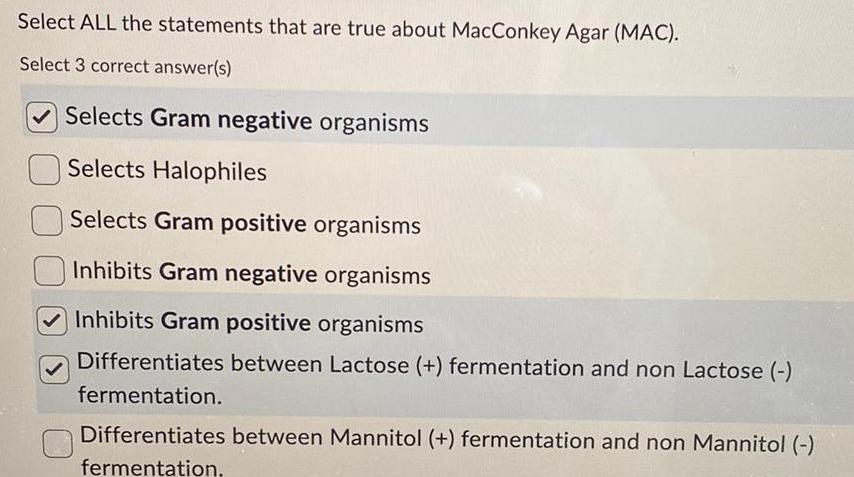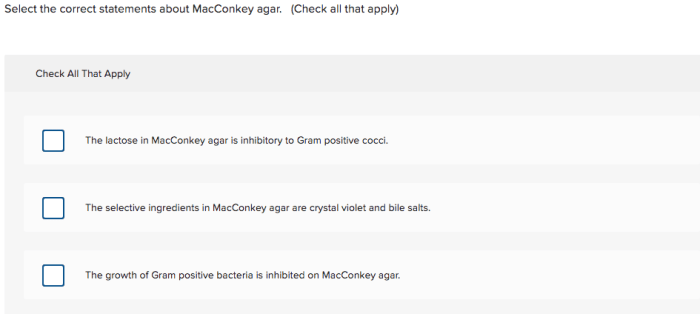Select the correct statements about macconkey agar. – MacConkey Agar: A Comprehensive Guide to Its Selective and Differential Properties
MacConkey agar, a cornerstone in microbiology, is a selective and differential culture medium designed to isolate and differentiate specific bacteria, particularly those associated with urinary tract infections. Its unique composition and properties make it an invaluable tool for clinical and research laboratories.
MacConkey Agar Overview: Select The Correct Statements About Macconkey Agar.

MacConkey agar is a selective and differential culture medium used to isolate and differentiate bacteria, particularly Gram-negative bacteria, based on their ability to ferment lactose and produce acid.
It is composed of peptone, sodium chloride, bile salts, crystal violet, neutral red, and lactose.
The selective properties of MacConkey agar are due to the presence of bile salts and crystal violet, which inhibit the growth of Gram-positive bacteria. The differential properties are due to the presence of lactose, which allows lactose-fermenting bacteria to produce acid and change the color of the medium.
Selective Properties
MacConkey agar inhibits the growth of Gram-positive bacteria due to the presence of bile salts and crystal violet.
- Bile salts disrupt the cell membranes of Gram-positive bacteria, making them more susceptible to lysis.
- Crystal violet is a cationic dye that binds to the negatively charged lipopolysaccharides in the outer membranes of Gram-negative bacteria, making them more permeable to bile salts.
Examples of Gram-positive bacteria that are inhibited by MacConkey agar include Staphylococcus aureusand Streptococcus pyogenes.
Differential Properties
MacConkey agar differentiates between lactose-fermenting and non-lactose-fermenting bacteria based on the production of acid.
Lactose-fermenting bacteria produce acid, which lowers the pH of the medium and causes the neutral red indicator to change color from red to yellow.
- Examples of lactose-fermenting bacteria include Escherichia coliand Salmonella enterica.
- Examples of non-lactose-fermenting bacteria include Pseudomonas aeruginosaand Proteus mirabilis.
Applications, Select the correct statements about macconkey agar.
MacConkey agar is used clinically to isolate and identify specific bacteria, such as E. coliand Salmonella.
It is also used to differentiate between lactose-fermenting and non-lactose-fermenting bacteria in water and food samples.
Other applications of MacConkey agar include:
- Detection of coliforms in water and food
- Identification of Shigellaand Yersiniaspecies
- Differentiation between Proteusand Providenciaspecies
FAQ Summary
What is the primary purpose of MacConkey agar?
MacConkey agar is primarily used to isolate and differentiate Gram-negative bacteria, particularly those associated with urinary tract infections.
How does MacConkey agar inhibit the growth of Gram-positive bacteria?
MacConkey agar contains crystal violet and bile salts, which inhibit the growth of Gram-positive bacteria by disrupting their cell membranes.
What is the significance of the color change observed on MacConkey agar?
The color change on MacConkey agar is due to the fermentation of lactose. Lactose-fermenting bacteria produce acid, causing the agar to turn pink or red, while non-lactose-fermenting bacteria do not change the color of the agar.

